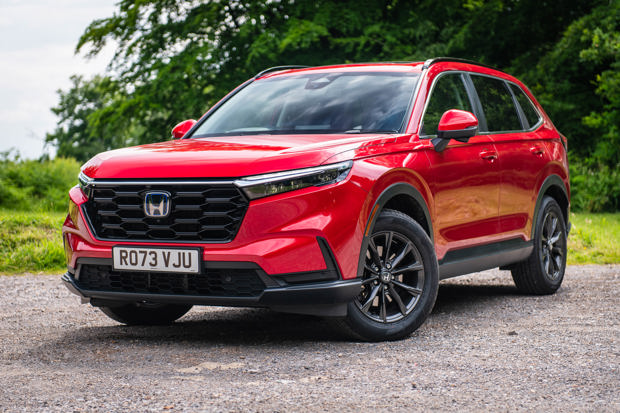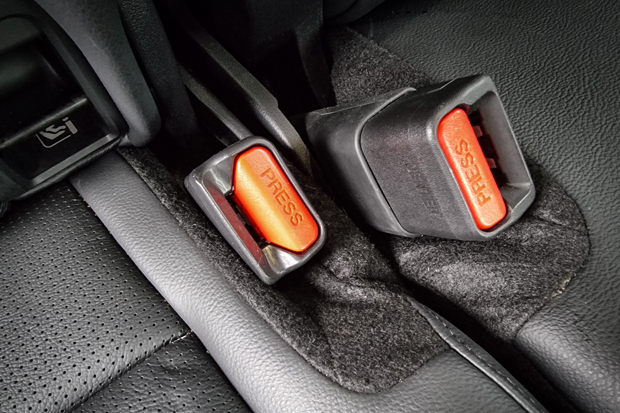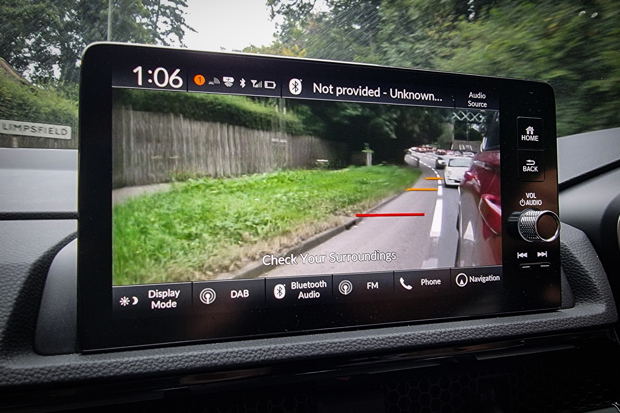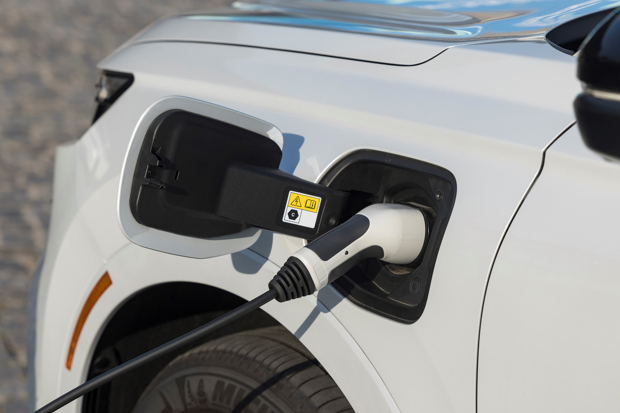Honda CR-V long-term review

Specifications: Honda CR-V Advance
- Run by: Phil Hall since June 2024
- Price when new: £49,030 (£50,025 including options)
- Engine: 2.0-litre hybrid
- Power: 184PS
- Torque: 335Nm
- Claimed economy: 42.8mpg
- CO2 emissions: 151g/km
- Insurance group: 36
Report 1: We welcome the Honda CR-V to our fleet
After three months with the ZR-V, we're upgrading to the bigger CR-V for three months.

Date: 25 June 2024 | Current mileage: 9883 miles | Claimed economy: 42.8mpg | Actual economy: 41.5mpg
Waving goodbye to our ZR-V long-termer was pretty easy as the nice man from Honda who was collecting it had rocked up in a CR-V to replace it with.
While the ZR-V was Honda's first stab at a family SUV, the CR-V is now in its sixth generation, having established itself as a comfy and reliable SUV in the last twenty five years or so its been knocking around.
Can this large SUV still cut it now there's more competition than ever? That's what hoping to find out over the next few months, so let's take a look at exactly what we're going to be living with.
Our Honda CR-V long-term test car comes with the familiar 2.0-litre self-charging hybrid engine that's impressed both in the Civic and ZR-V that we've previously run, so it'll be interesting to see how the heavier CR-V gets on with this motor.

Finished in top-of-the-range Advanced trim, there's no shortage of kit as standard on the CR-V. This includes little luxuries like a panoramic roof, 12-speaker Bose sound system, multi-view camera and heated front seats. You still need a USB lead though to connect to Android Auto...a touch disappointing in a car costing just over £50,000.
And yes, we did say £50,000. Well, with the optional Premium Crystal red paint at £995, the bottom line is £50,025 if you were paying cash. Compared to mainstream hybrid rivals like the Hyundai Tuscon, Ford Kuga and VW Tiguan, that's a significant wedge more than all of these.
Honda will tell you its their most premium family SUV yet, and it's hard to quibble with them here. While it looks similar to the interior of the ZR-V (and the Civic for that matter), it somehow feels a step up in quality. Whether that'll be enough to justify the premium over similar rivals will come down to you (and what kind of PCP deal you can find).
The last time I drove the current Honda CR-V was on its international launch in sunny Porto last year, so I'm looking forward to spending a few months with this one in less glamorous surroundings to see how it copes on UK roads and the demands of family life.
Report 2: The CR-V's huge boot comes in handy
A weekend camping trip makes us appreciate the huge boot on the Honda CR-V.

Date: 9 July 2024 | Current mileage: 10,172 miles | Claimed economy: 42.8mpg | Actual economy: 41.9mpg
Swapping the ZR-V for the CR-V has been a bit like going from a three-bed semi-detached to a four bed detached house. There's just more space everywhere.
Measuring 4706mm long, 1866mm wide and 1673mm tall, the CR-V is some 138mm longer, 26mm wider and 53mm taller than the ZR-V. Not only does that make for a roomy cabin, especially in the back, but it makes the boot significantly larger.
Now I might have smugly suggested that the 370-litre boot in the ZR-V we ran was perfectly adequate for my family's needs. But that was before I'd been camping as a family of four.
With a large tent, blow-up mattresses, bedding, tables and chairs, clothing, food and a coolbox just some of the things we 'needed' to take, cramming it all in the ZR-V would have been impossible. The CR-V on the other hand didn't even flinch as I loaded it up.
This is all thanks to the CR-V's generous boot - at 596 litres that boot space, it offers one of the large boots in its class. This is in some part thanks to the boxier profile of the CR-V over the more coupe-esque styling of the ZR-V, as well as being that bit longer. It was also a really useful shape, meaning we could pack our stuff away without wasting unnecessary space here and there.
While camping in our household might be limited to one or two trips a year, having this well-proportioned boot at our our disposal was incredibly handy. It meant we could pack everything we needed with ease and since then I've even managed to happily fit a gravel bike in the back (admittedly with the wheels removed) without the CR-V even flinching.
Looking at it very simplistically for a second and a similar spec'd CR-V costs about £6-7000 more than an equivalent ZR-V, and while the larger car certainly has a few more niceties (and we reckon looks better, too), you in essence paying for more space. Now some might feel they'd sooner leave the tent it home and put some of that money saved into a nice hotel, but for others the extra versatility and comfort will be well worth the extra outlay.
Report 3: Seatbelt frustrations
Anyone with kids will tell you getting them secured in the back can be a faff, but the CR-V is making things that bit harder.

Date: 23 July 2024 | Current mileage: 10,786 miles | Claimed economy: 42.8mpg | Actual economy: 41.7mpg
My girls are five and seven and if I could freeze them at this age, I'd seriously consider it. It's wonderful seeing them grow and become more independent, but if I could press pause for a bit, that would be lovely. One thing that would tempt me to hit play again would be for them to no longer need a child seat.
Anyone who's had to funnel and shove children into a child car seat and fasten it whilst leaning through the rear door opening will tell you it's not a fun or easy experience. I've also lost track of the times I've been ready to set off before yells from the back of "I'm not clipped in".
You want the process to be as quick and as hassle free as possible. Especially if its raining and you're running late. However, our long-term Honda CR-V is making this process even more frustrating.
It's not the rear door opening, which is fantastic - it swings open by about 90-degrees, making it nice and easy for both children to hop in and adults to stretch across and fumble for the seat belt buckle, but once you're inside that the issue occurs.

You see, unlike some car seat buckles that have a reasonable amount of movement in them (especially when it comes to moving left and right), the CR-V's only has very limited movement up and down thanks to the nature of the seat design.
Our youngest daughter's Group 2 car seat isn't too bad as the ISOFIX attachment from the seat provides some movement that makes it possible to fasten the belt (but it could be much easier), but the trouble occurs when our eldest daughter's seat.
She's now now large enough for a booster seat and so we've got her a Graco one with ISOFIX connectors. However, rather than use seat belt webbing to connect the seat to the ISOFIX lugs, they're on metal runners that have no lateral movement. With the seat in place it's impossible to fasten the seat belt as the buckle is tucked behind and won't pull out or move left or right. One solution is to not to use the ISOFIX connector as it can tuck into the frame of the seat, but it's still not easy and not a great compromise.
It's something that we didn't have an issue with on the ZR-V we ran before it, so it's a curious (and frustrating) issue to find on the CR-V.
Report 4: Getting to grips with Lane Watch
Our Honda CR-V is adorned with an array of cameras that results in some clever little features.

Date: 6 August 2024 | Current mileage: 10,982 miles | Claimed economy: 42.8mpg | Actual economy: 42.0mpg
Unlike the single reserving camera on our ZR-V that we ran previously, our CR-V long-termer is adorned with multiple cameras.
That means that I can get a bird's eye view of things when I'm parking, but what I like about this system is that I get a dual feed.
Unlike a lot of rivals that either give me a 360-degree view or a feed from a single camera, the CR-V gives me both at the same time. On the left of the screen I get the rear camera that's supplemented by a 360-degree view on the right. Even on the modestly sized screen, these work well side-by-side and the clarity from each feed is really good. It's also nice and easy to toggle between cameras should you want to see what's in front on at the side.
Speaking of which, our Honda CR-V long-termer is equipped with something called Lane Watch. It takes a feed from the left-hand door camera and relays it onto the 9-inch display so you can easily see what's in your blindspot.
The system can be set-up so its active every time you indicate left, but it does mean that other info (such a your navigation or Google Maps) will monetarily disappear, which might not be that handy when trying to find your way round somewhere new. It can be easily turned off though by press the dedicated button at the end of the indicator stork if it does become a nuisance.
I've set it up so it only comes on when you press the Lane Watch button and I have to say that its a handy feature when on a busy motorway, allowing me to have quick visual glance that there's nothing there. I also like how there are red and orange markers overlaid on the display show how close other vehicles are.
It seems a little odd that Honda's restricted this to just the left door camera, and not the right as well. I'm sure it could be easily integrated and would be just as useful to have when pulling out into faster moving traffic.
Report 5: Should you choose a CR-V e-PHEV over a e:HEV?
With the option of a plug-in hybrid CR-V, which one should you choose?

Date: 23 August 2024 | Current mileage: 11,345 miles | Claimed economy: 42.8mpg | Actual economy: 41.2mpg
I've become pretty familiar with Honda's 184PS e:HEV hybrid engine, with it being found in both the Civic and ZR-V I've run over the past year or so. It's a brilliant all-rounder, delivering a good blend of performance and fuel economy.
While both the Civic and ZR-V are only available with this self-charging hybrid engine, the CR-V is also available with a plug-in hybrid (PHEV) set-up. Would this be the more desirable option to go for if you had the choice? As is the case with these things, it's swings about roundabouts.
Compared to a lot of rivals, Honda's done things a little differently. While rivals tend to bless PHEV versions with more power and extra motors, the CR-V e:PHEV uses the same 2.0-litre petrol engine as the starting point, but it benefits from a significantly bigger battery than the standard hybrid model. This means the power is still the same at 184PS, but the electric range is 51 miles.
This set-up means that unlike PHEV rivals that tend to see a bump in performance over the standard version, the 0-62mph time of both the e:HEV and e:PHEV CR-V are exactly the same at 9.4 seconds. There are still some differences elsewhere though.
The e:PHEV has adaptive dampers for a start for a smoother ride, though it's only two-wheel drive and not four like the e:HEV. Unlike a lot of PHEVs that sacrifice some boot space to accommodate the larger batteries, the CR-V e:PHEV actually has a larger boot thanks to some clever packaging, increasing from 596 litres to 635 litres. And while you can't tow with the standard CR-V, the CR-V e:PHEV can pull a load up to 1500kg.
And what about fuel economy? The e:HEV can officially achieve 42.8mpg, while the e:PHEV should officially return 45.6mpg once the battery has been run down. I'm not sure what kind of witchcraft is going on there as logic would dictate that the car with the smaller battery should return the better fuel economy.
Perhaps the biggest deciding factor is the price. You'll pay a premium of around £8000 for the e:PHEV, which is about typical for the plug-in hybrid version of a family SUV. Private buyers might baulk at this, but company car drivers will be attracted to the savings that can be made by running a PHEV.
So, which one would I pick? I've run a few PHEVs in the past and the ability to charge at home and run under electric power alone for a lot of local trips does make the plug-in hybrid a tempting proposition, but having run the e:HEV for a couple of months now, it hasn't felt like I've been running the poor relation that can be the case with other cars.
It might not be quite as smooth on the road as the e:PHEV CR-V or deliver quite the same mpg, but I'd be tempted to save some money up front and stick with the standard car.
Report 6: Goodbye to our Honda CR-V
After three months living with our Honda CR-V long-term test car, it's time to wave goodbye.

Date: 18 September 2024 | Current mileage: 11,981 miles | Claimed economy: 42.8mpg | Actual economy: 40.0mpg
After three months running the Honda CR-V, it's time to say goodbye to our dependable family SUV. Switching from the ZR-V to the CR-V definitely felt like a step up, and not simply because it was that bit larger.
The interior for starters is just that bit nicer, with some plusher materials employed round the cabin. The seats have proved to be really comfy and there were no complaints from the girls in the back (though we're still frustrated by the rear seatbelt buckles) on longer journeys, which surely has to be a win.
It's also incredibly easy to live with. Jumping into some cars and getting to grips with overly complicated touchscreens and infotainment systems can be frustrating, but in the CR-V, it couldn't be simpler. Admittedly there's a little familiarity here from my time from using a virtually identical system in the ZR-V, but even first time users will be able to find 6Music and quickly adjust the temperature via the dedicated climate control dials.
The 9.0-inch screen might not be as flashy and large as some, but it's easy to navigate when you do need to venture deeper into the CR-V's menu, while there's Apple CarPlay or Android Auto on hand as well. It still confuses me though that on a car costing over £50,000, wireless Android Auto connectivity isn't available. It makes the wireless charging a pretty pointless feature as well.
There's bags of space in the CR-V - the cabin is huge, with the panoramic roof and light rooflining adding to the airy feel. The ease at which the rear bench seat slid back and fourth meant it was a breeze to alter the boot capacity - even with the seats set forward as far as they would go to maximise boot space, my girls still had a decent amount of legroom. For most of the time though that seats were put back as for day-to-day use, the boot space on the CR-V was more than ample.
The hybrid engine in the CR-V also impresses. Probably not to quite the same levels has it has in the Civic, but its a solid performance and means for the short runs I'm bumbling around on electric power alone. It was also pretty frugal, getting close the the claimed 42.8mpg most of the time. Reliability has been rock-solid as well, with not a single fault (or creak or groan) appearing during our time with it.
The Honda CR-V then is a very capable family SUV that has a lot going for it. My only major issue is the price. Rivals like the Toyota RAV4 are about £5000-6000 less, while a Volvo XC60 in Plus trim is pretty much the same price. While the XC60 might be showing its age, it's still one of the best looking family SUVs going. Would I order a CR-V if I could get one of these for the same money? I'm not so sure.
